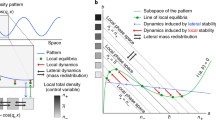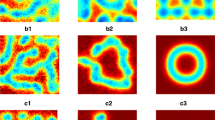Abstract
We investigate Turing pattern formation in a stochastic and spatially discretized version of a reaction–diffusion–advection (RDA) equation, which was previously introduced to model synaptogenesis in C. elegans. The model describes the interactions between a passively diffusing molecular species and an advecting species that switches between anterograde and retrograde motor-driven transport (bidirectional transport). Within the context of synaptogenesis, the diffusing molecules can be identified with the protein kinase CaMKII and the advecting molecules as glutamate receptors. The stochastic dynamics evolves according to an RDA master equation, in which advection and diffusion are both modeled as hopping reactions along a one-dimensional array of chemical compartments. Carrying out a linear noise approximation of the RDA master equation leads to an effective Langevin equation, whose power spectrum provides a means of extending the definition of a Turing instability to stochastic systems, namely in terms of the existence of a peak in the power spectrum at a nonzero spatial frequency. We thus show how noise can significantly extend the range over which spontaneous patterns occur, which is consistent with previous studies of RD systems.








Similar content being viewed by others
References
Arpag G, Norris SR, Mousavi SI, Soppina V, Verhey KJ, Hancock WO, Tuzel E (2019) Motor dynamics underlying cargo transport by pairs of Kinesin-1 and Kinesin-3 Motors. Biophys J 116(6):1115–1126
Biancalani T, Fanelli D, Di Patti F (2010) Stochastic Turing patterns in the Brusselator model. Phys Rev E 81:046215
Biancalani T, Jafarpour F, Goldenfeld N (2017) Giant amplification of noise in fluctuation-induced pattern formation. Phys Rev Lett 118:018101
Bressloff PC (2014) Stochastic processes in cell biology. Springer, New York
Brooks HA, Bressloff PC (2016) A mechanism for Turing pattern formation with active and passive transport. SIAM J Appl Dyn Syst 15(4):1823–1843
Brooks HA, Bressloff PC (2017) Turing mechanism for homeostatic control of synaptic density during C. elegans growth. Phys Rev E 96:012413
Butler TC, Goldenfeld N (2009) Robust ecological pattern formation induced by demographic noise. Phys Rev E 80:030902(R)
Butler TC, Goldenfeld N (2011) Fluctuation-driven Turing patterns. Phys Rev E 84:011112
Cross MC, Greenside HS (2009) Pattern formation and dynamics in non-equilibrium systems. Cambridge University Press, Cambridge
De Anna PD, Patti FD, Fanelli D, McKane AJ, Dauxois T (2010) Spatial model of autocatalytic reactions. Phys Rev E 81:056110
Di Patti F, Lavacchi L, Arbel-Goren R, Schein-Lubomirsky L, Fanelli D, Stavans J (2018) Robust stochastic Turing patterns in the development of a one-dimensional cyanobacterial organism. Plos Biol 16(5):e2004877
Gierer A, Meinhardt H (1972) A theory of biological pattern formation. Kybernetik 12:30–39
Hanus C, Schuman EM (2013) Proteostasis in complex dendrites. Nature Rev Neurosci 14:638–648
Hillen T (1996) A Turing model with correlated random walk. J Math Biol 35:49–72
Hoerndli FJ, Maxfield DA, Brockie PJ, Mellem JE, Jensen E, Wang R, Madsen DM, Maricq AV (2013) Kinesin-1 regulates synaptic strength by mediating the delivery, removal, and redistribution of AMPA receptors. Neuron 80:1421–1437
Hoerndli FJ, Wang R, Mellem JE, Kallarackal A, Brockie PJ, Thacker C, Jensen E, Madsen DM, Maricq AV (2015) Neuronal activity and CaMKII regulate kinesin-mediated transport of synaptic AMPARs. Neuron 86:457–474
Kariga D, Martinic KM, Lud T, DeLateure NA, Goldenfeld N, Weiss R (2018) Stochastic Turing patterns in a synthetic bacterial population. PNAS 115(26):6572–6577
Lugo CA, McKane AJ (2008) Quasicycles in a spatial predator–prey model. Phys Rev E 78:051911
McKane AJ, Biancalani T, Rogers T (2014) Stochastic pattern formation and spontaneous polarisation: the linear noise approximation and beyond. Bull Math Biol 76:895–921
Monteiro MI, Ahlawat S, Kowalski JR, Malkin E, Koushika SP, Juoa P (2012) The kinesin-3 family motor KLP-4 regulates anterograde trafficking of GLR-1 glutamate receptors in the ventral nerve cord of Caenorhabditis elegans. Mol Biol Cell 23:3647–3662
Murray JD (2008) Mathematical biology, vol II, 3rd edn. Springer, Berlin
Rongo C, Kaplan JM (1999) CaMKII regulates the density of central glutamatergic synapses in vivo. Nature 402:195–199
Schumacher LJ, Woolley TE, Baker RE (2013) Noise-induced temporal dynamics in Turing systems. Phys Rev E 87:042719
Turing AM (1952) The chemical basis of morphogenesis. Philos Trans Roy Soc Lond Ser B Biol Sci 237:37–72
Walgraef D (1997) Pattern formation with examples from physics, chemistry, and materials science. Springer, New York
Woolley TE, Baker RE, Gaffney EA, Maini PK (2011) Stochastic reaction and diffusion on growing compartments: understanding the breakdown of robust pattern formation. Phys Rev E 84:046216
Author information
Authors and Affiliations
Corresponding author
Additional information
Publisher's Note
Springer Nature remains neutral with regard to jurisdictional claims in published maps and institutional affiliations.
Exact Forms of the Macroscopic and Mesoscopic Models
Exact Forms of the Macroscopic and Mesoscopic Models
1.1 Reaction Components of Macroscopic Model
Multiplying \({\mathbf {L}}\) and \({\mathbf {F}}({\mathbf {u}})\) in Sect. 2 yields
Since this multiplication is the local reaction component of the macroscopic model, we have
where
Thus, the Jacobian of \({\mathbf {G}}\) at \({\mathbf {u}}^*\) becomes
where the partial derivatives \(g_{1,m} = \left. \partial g_1/\partial u_m\right| _*\) are
and \(g_{2,m} = \left. \partial g_2/\partial u_m\right| _*\)
In particular, if \(\beta _1 = \beta _2 = 0\), then the partial derivatives reduce to
1.2 Characteristic Equation for the Linearized Macroscopic Equations
The linear operator \({\mathcal {L}}(k)\) in the characteristic equation (22) can be reduced to the form
in accordance with the substitution \(q = \cos (k) -1\). The corresponding characteristic equation is
where
The coefficients \(p_{j,m}\) are given by
and
Note that if \(\beta _1 = \beta _2 = 0\), then the coefficients \(p_j(q)\) are independent of \(\rho _1\) and \(\rho _2\). Moreover, Eq. (A.6) implies that the partial derivatives are independent of \(\rho _2\), and only \(g_{1,2}\) and \(g_{2,1}\) depend on \(\rho _1\). However, the latter coefficients always appear in \(p_{j,m}\) as the product \(g_{1,2}g_{2,1} = -\mu _1\mu _2\), which is independent of \(\rho _1\). This establishes the above claim.
The coefficient \(p_j(q)\) also determines the Turing–Hopf bifurcation condition (28)
In order to investigate its behavior over \(q \in [-2,0]\), we first compute
Using the fact that \(g_{2,2} = - \mu _2\) and the stability condition (19)
one can show \(p_{\text {TH},0}> 0\). Similarly, we find the sign of higher-order coefficients. The leading coefficient is
which is negative. The next leading coefficient can be written as
which is positive. Introducing variables
which are all positive, the first-order coefficient takes the form of
which right-hand side becomes positive. Thus, we have \(p_{\text {TH},1}<0\). From the above results, we conclude that \(p_\text {TH}(q) >0\) for \(q \in [-2,0]\).
1.3 Components of Correlation Matrices in the Mesoscopic Model
The nonzero components of \({\mathbf {B}}_{1,n}({\mathbf {u}})\) are
Similarly, the elements of the diagonal matrices \({\mathbf {B}}_{2,n}({\mathbf {u}})\) and \({\mathbf {B}}_{3,n}({\mathbf {u}})\) are
and
1.4 Coefficients in Stochastic Turing Pattern Condition
The first element of the power spectral density is given by Eq. (56), and the coefficients have the following explicit forms:
and
Taking the limit \(\alpha \rightarrow \infty \) in the stochastic Turing condition (57), we have a quadratic Eq. (60) and its coefficients are the following:
Rights and permissions
About this article
Cite this article
Kim, H., Bressloff, P.C. Stochastic Turing Pattern Formation in a Model with Active and Passive Transport. Bull Math Biol 82, 144 (2020). https://doi.org/10.1007/s11538-020-00822-y
Received:
Accepted:
Published:
DOI: https://doi.org/10.1007/s11538-020-00822-y




